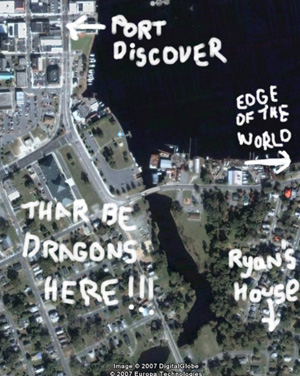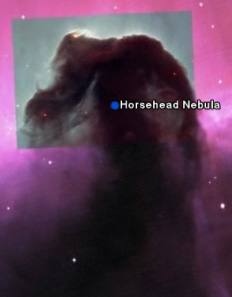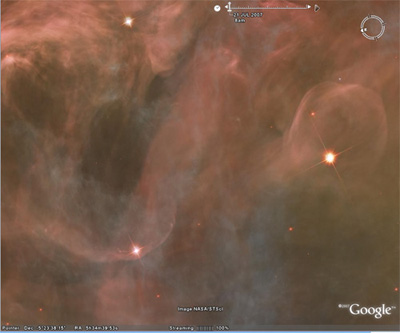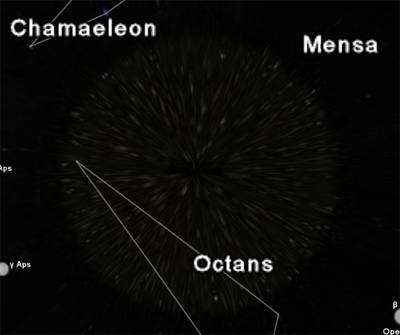 Google Earth: I can see my house from up here. |
It was a tremendous relief when Elizabeth City finally got scanned into Google Earth. Having this application installed on the Science Center’s computers, it was disheartening to zoom in on the center and find the satellite view blurry and indistinct. Even without Elizabeth City in the application, Google Earth provides an incredible perspective on our pale blue dot of a biome and has even become an invaluable tool for scientific research.
Now comes Google Space (Google Earth 4.2). With the click of a button, the Earth vanishes and we are hurtled into a night sky filled with star names, constellations, planets, and fantastically detailed Hubble space telescope images.
 Horsehead Nebula |
For the first time, I actually got to see the horse head in the horse head nebula. So many astronomy books and NASA photos of this object render it in such detail that I couldn’t understand the name. It’s only when you pull back, and see this cloud of dust hundreds of thousands of miles across as a distant blob–the same way it looked through earlier telescopes–that you can see the knight chess piece it is fabled to resemble.
I soon couldn’t resist actively hunting for familiar objects I’d seen in Hubble Space Telescope photos. Were there any bok globule’s in Orion’s Nebula? I couldn’t find any, but Google Space presents the Nebula in such size and detail, I could easily have missed the phenomena.
I did, however, find these two gaseous arcs. The star on the left has created an arc around it as the interstellar winds blow by it, while the star on the right appears to be pushing the gases out into a bubble shape around it.
 Arching Gases in Orion’s Nebula |
The search feature was a wild ride. Flying through space and zooming into the Cartwheel Galaxy, Sombrero Galaxy, or all the different stars named Monocerotis trying to find one of the most eerily beautiful nebulas in the night sky. I eventually did find this jewel, when I zoomed in on an object labeled “Light Echoes” to the west of Monoceros.
The planets suck. You click on Jupiter and the program zooms in past the Milky Way, and the gas giant doesn’t get any closer. We just get a “Check out Jupiter on Wikipedia” link. I’ll keep in mind that this is a work in progress, and the folks at Google will come up with a way to give me a 360-degree view of each planet, complete with moons. They have had their hands full with the monumental task of trying to get Elizabeth City’s awesome micropolis into the application without bringing down their servers after all.
I learned in childhood that the Sun was on the outer edge of the Milky Way, that we are on the end of a spiral arm out in the middle of nowhere, but this is not exactly true. We are still out in the middle of nowhere, but we actually on a piece of a spiral arm called the Orion Spur, between the Perseus and Sagittarius spiral arms. Google Space illustrates our locality inside the Milky Way, as opposed to outside it, when we spin around in a complete 360-degree and find the ring of stars encircles us.
There’s still much adventuring to do in this application, which, like Google Earth, will certainly grow in detail with time. I still have the Carina Nebula, Eagle Nebula, and the gaping hole in the universe to go searching for.
 What is this? (Not the gaping hole in the universe) |
Oh! And what about comets? I didn’t even think to go searching for Hailey’s. And what does it look like when you go back to Earth after adventuring in space?
This is such an important piece of software, as we live in a world where light pollution drowns out all but a dozen stars in the night sky for most of the world’s population. Is it ironic that hunching over in front of our computer monitors, staring at computer simulations of our night sky can inspire the human race to start thinking about “out there” again?